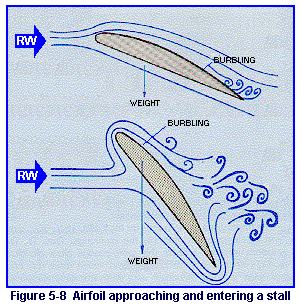 |
|||||
| Home | Research | For Teachers | HISTORY Level 1 Level 2 Level 3 |
PRINCIPLES Level 1 Level 2 Level 3 |
CAREER Level 1 Level 2 Level 3 |
| Gallery | Hot Links | What's New! | |||
| Web Administration and Tools | |||||
 |
|||||
| Home | Research | For Teachers | HISTORY Level 1 Level 2 Level 3 |
PRINCIPLES Level 1 Level 2 Level 3 |
CAREER Level 1 Level 2 Level 3 |
| Gallery | Hot Links | What's New! | |||
| Web Administration and Tools | |||||
![]()
 Since stalls are the cause of much concern among student
pilots and the nonflying public, we will discuss them here. We mentioned that an airplane
must attain flying speed in order to take off. Sufficient airspeed must be maintained
in flight to produce enough lift to support the airplane without requiring too large an
angle of attack. At a specific angle of attack, called the critical angle of attack, air
going over a wing will separate from the wing or "burble" (see figure 5-8 ),
causing the wing to lose its lift (stall). The airspeed at which the wing will not
support the airplane without exceeding this critical angle of attack is called the
stalling speed. This speed will vary with changes in wing configuration (flap position).
Excessive load factors caused by sudden maneuvers, steep banks, and wind gusts can also
cause the aircraft to exceed the critical angle of attack and thus stall at any airspeed
and any attitude. Speeds permitting smooth flow of air over the airfoil and control
surfaces must be maintained to control the airplane.
Since stalls are the cause of much concern among student
pilots and the nonflying public, we will discuss them here. We mentioned that an airplane
must attain flying speed in order to take off. Sufficient airspeed must be maintained
in flight to produce enough lift to support the airplane without requiring too large an
angle of attack. At a specific angle of attack, called the critical angle of attack, air
going over a wing will separate from the wing or "burble" (see figure 5-8 ),
causing the wing to lose its lift (stall). The airspeed at which the wing will not
support the airplane without exceeding this critical angle of attack is called the
stalling speed. This speed will vary with changes in wing configuration (flap position).
Excessive load factors caused by sudden maneuvers, steep banks, and wind gusts can also
cause the aircraft to exceed the critical angle of attack and thus stall at any airspeed
and any attitude. Speeds permitting smooth flow of air over the airfoil and control
surfaces must be maintained to control the airplane.
Flying an airplane, like other skills that are learned, requires practice to remain proficient. Professional pilots for the major airlines, military pilots, and flight instructors all return to the classroom periodically for updating their skills. Good judgment must be exercised by all pilots to ensure the safe and skillful operation of the airplanes they fly.
Send all comments to ![]() aeromaster@eng.fiu.edu
aeromaster@eng.fiu.edu
© 1995-98 ALLSTAR Network. All rights reserved worldwide.
| Funded in part by | From Civil Air Patrol Educational Materials |
Updated:February 23, 1999